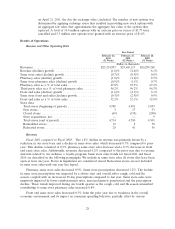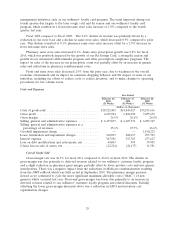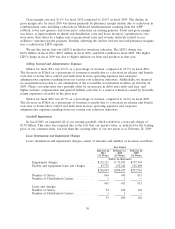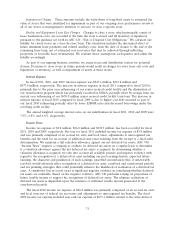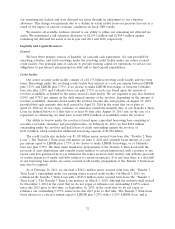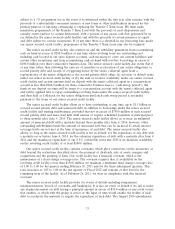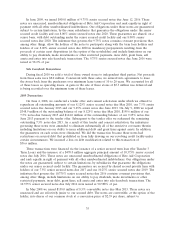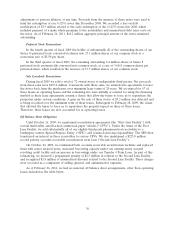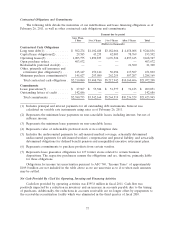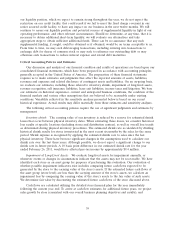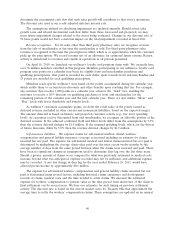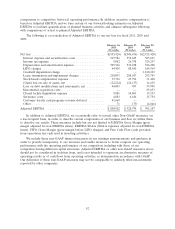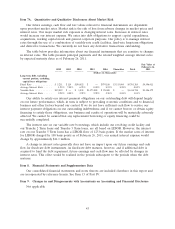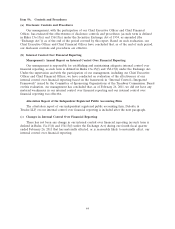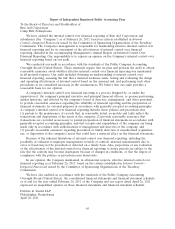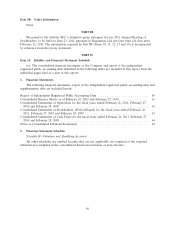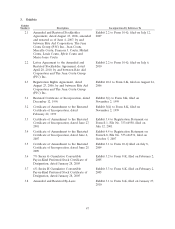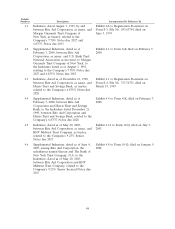Rite Aid 2011 Annual Report Download - page 38
Download and view the complete annual report
Please find page 38 of the 2011 Rite Aid annual report below. You can navigate through the pages in the report by either clicking on the pages listed below, or by using the keyword search tool below to find specific information within the annual report.Cash flow used in operating activities was $325.1 million in fiscal 2010. Cash flow was negatively
impacted by the repayments of the accounts receivable securitization facilities totaling $555.0 million
and a decrease in accounts payable offset by a reduction in inventory and accounts receivable. The
decreases in accounts receivables, inventory and accounts payable were due to operating fewer stores
and various working capital initiatives.
Cash flow provided by operating activities was $359.9 million in fiscal 2009. Cash flow was
positively impacted by net proceeds from our accounts receivable securitization, reductions in accounts
receivable and inventory, partially offset by a decrease in accounts payable. The decrease in inventory is
primarily due to the efforts made by management to reduce excess inventory and a decrease in
purchasing volume, which also impacted accounts payable.
Cash used in investing activities was $156.7 million in fiscal 2011. Cash was used for the purchase
of property, plant and equipment and prescription files which was partially offset by proceeds from
asset dispositions
Cash used in investing activities was $120.5 million in fiscal 2010. Cash was used for the purchase
of property, plant and equipment and prescription files which was offset in part by proceeds from asset
dispositions.
Cash used in investing activities was $346.4 million in fiscal 2009. Cash was used for the purchase
of property, plant and equipment and prescription files which was offset in part by proceeds from our
sale leaseback transactions and proceeds from asset dispositions.
Cash used in financing activities was $251.7 million in fiscal 2011 and was primarily due to the
refinancing activity that occurred during the second quarter of fiscal 2011, the repurchase of
$93.8 million of the Convertible Notes, other scheduled debt repayments and a small decrease in our
zero balance cash accounts.
Cash provided by financing activities was $397.1 million in fiscal 2010 due to proceeds from
refinancings offset by a reduction in borrowings on our revolving credit facility and the payment of
financing fees related to the refinancings.
Cash used in financing activities was $17.3 million in fiscal 2009 due to the net impact of proceeds
from the issuance of convertible notes and redemption of various notes, amending of our credit facility
and principal payments on long term debt.
Capital Expenditures
We plan to make total capital expenditures of approximately $300.0 million during fiscal 2012,
consisting of approximately 10% related to the new store construction and store relocation, 42%
related to store remodels, 25% related to prescription file purchases and 23% for infrastructure and
maintenance requirements. Management expects that these capital expenditures will be financed
primarily with cash flow from operating activities and use of the revolving credit facility.
Future Liquidity
We are highly leveraged. Our high level of indebtedness: (i) limits our ability to obtain additional
financing; (ii) limits our flexibility in planning for, or reacting to, changes in our business and the
industry; (iii) places us at a competitive disadvantage relative to our competitors with less debt;
(iv) renders us more vulnerable to general adverse economic and industry conditions; and (v) requires
us to dedicate a substantial portion of our cash flow to service our debt. Based upon our current levels
of operations, we believe that cash flow from operations together with available borrowings under the
senior secured credit facility and other sources of liquidity will be adequate to meet our requirements
for working capital, debt service and capital expenditures at least for the next twelve months. Based on
38


